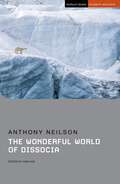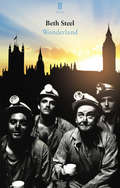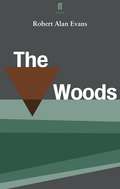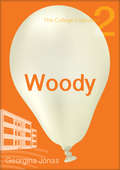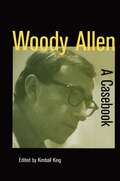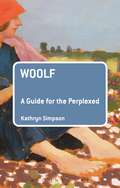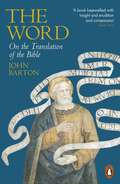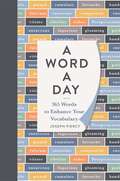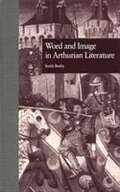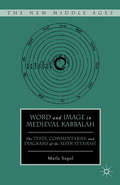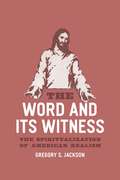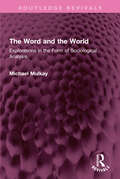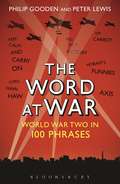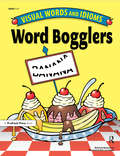- Table View
- List View
Wonderful World of Dissocia (Student Editions)
by Anthony Neilson'Anthony Neilson's 2004 play is half a lark, half deadly serious' TIME OUT'A profane, madcap, Alice-in-Wonderland trip morphs into something much more profound in Anthony Neilson's weirdly compelling 2004 study of mental instability' EVENING STANDARD Lisa Jones is on a journey. It's a colourful and exciting off-kilter trip in search of one lost hour that has tipped the balance of her life. The inhabitants of the wonderful world she finds herself in – Dissocia – are a curious blend of the funny, the friendly and the brutal. This Student Edition of Anthony Neilson's 2004 play, which premiered at the Edinburgh International Festival, features a commentary and notes by anna six. It introduces students to debates surrounding mental health and situates Neilson within a British theatrical tradition, including through an interview with him.
Wondering about the Impossible: On the Semantics of Counterpossibles (Synthese Library #487)
by Maciej SendłakThis book provides an in-depth analysis of the nature and role of hypothetical reasoning about impossibilities. The interest in this subject stems from the simple observation that wondering is an inherent aspect of our experience. Whether one regrets choosing a taxicab over the subway or contemplates the outcome of an election turning out differently, the question 'What would have happened if...?' is a familiar one. While we often focus on possible scenarios, we also ponder impossible ones: What if whales were fish? What if a man could be in two places at once? What if one could draw a round square? Puzzles concerning such questions sparked a heated discussion over the nature and role of hypothetical reasoning about impossibilities. This book goes beyond being an opinionated introduction to this debate. After comparing various approaches to this issue, it proposes a novel perspective that draws on considerations from epistemology and the philosophy of explanation and dependence. Targeting researchers and students interested in the philosophy of modalities, this book delivers an in-depth analysis of a captivating and often overlooked aspect of human reasoning.
Wonderland
by Beth SteelThe Midlands, 1984. Two young lads are about to learn what it is to be a miner, to be accepted into the close camaraderie and initiated into a unique workplace where sweat, toil, collapsing roofs and explosions are all to be met with bawdy humour.London, 1984. A conflicted Tory MP, a brash American CEO and an eccentric maverick are the face of a radical Conservative government preparing to do battle with the most powerful workforce, the miners.As the two sides clash, the miners fight for their livelihoods and families, and the government for its vision of a free Britain. Together they change the fabric of the nation forever.Wonderland by Beth Steel premiered at the Hampstead Theatre, London, in June 2014.
Wonderworks: Literary invention and the science of stories
by Angus Fletcher'Fascinating. It blew my mind!' Malcolm Gladwell Wonderworks reveals that literature is among the mightiest technologies that humans have ever invented, precision-honed to give us what our brains most want and need. Literature is a technology like any other. And the writers we revere – from Homer to Shakespeare, Austen to Ferrante – each made a unique technical breakthrough that can be viewed as both a narrative and neuroscientific advancement. But literature’s great invention was to address problems we could not solve: not how to start a fire or build a boat, but how to live and love; how to maintain courage in the face of death; how to account for the fact that we exist at all. Based on Angus Fletcher’s own research, Wonderworks tells the story of the greatest literary inventions through the ages, from ancient Mesopotamia to modern-day America. It draws on cutting-edge neuroscience to demonstrate that the inventions really work: they enrich our lives with joy, hope, courage and energy, and they help our brains heal from grief, loneliness and even trauma. From ancient Chinese lyrics to nursery rhymes and fairy tales, from slave narratives to contemporary TV shows, Wonderworks walks us through the evolution of literature’s crucial blueprints, and offers us a new understanding of its power.
The wood engravers' self-portrait: The Dalziel Archive and Victorian illustration
by Bethan StevensThe wood engravers’ self-portrait tells the story of the image-making firm Dalziel Brothers, investigating and interpreting a unique archive from the British Museum. The study takes a creative-critical approach to illustration, alongside detailed investigation of print techniques and history. Five siblings ran the wood engraving firm Dalziel Brothers: George, Edward, Margaret, John and Thomas Dalziel. Prospering through five decades of work, Dalziel became the major capitalist image makers of Victorian Britain. This book, based on AHRC-funded research, outlines the achievements of these remarkable siblings and uncovers the histories of some of the 36 unknown artisan employees that worked alongside them. Dalziel Brothers made works of global importance: illustrations to Lewis Carroll’s Alice books, novels by Charles Dickens, and landmark Pre-Raphaelite prints, as well as other, brilliant works that are published here for the first time since their initial creation.
The wood engravers' self-portrait: The Dalziel Archive and Victorian illustration
by Bethan StevensThe wood engravers’ self-portrait tells the story of the image-making firm Dalziel Brothers, investigating and interpreting a unique archive from the British Museum. The study takes a creative-critical approach to illustration, alongside detailed investigation of print techniques and history. Five siblings ran the wood engraving firm Dalziel Brothers: George, Edward, Margaret, John and Thomas Dalziel. Prospering through five decades of work, Dalziel became the major capitalist image makers of Victorian Britain. This book, based on AHRC-funded research, outlines the achievements of these remarkable siblings and uncovers the histories of some of the 36 unknown artisan employees that worked alongside them. Dalziel Brothers made works of global importance: illustrations to Lewis Carroll’s Alice books, novels by Charles Dickens, and landmark Pre-Raphaelite prints, as well as other, brilliant works that are published here for the first time since their initial creation.
The Woods
by Robert Alan EvansWhy you always got to dig things up?A cabin deep in the woods.A lost boy buried in the snow.A lone woman.And her wolf.You think you could keep him?You know where that ends up.Don't you.You no good with kids.The Woods by Robert Alan Evans premiered at Royal Court Theatre, London, in September 2018.
Woody (The\college Collection #2)
by Georgina JonasWoody loves music, but can't play an instrument - as his family's reactions make clear. Will he find his true talent?
Woody Allen: A Casebook
by Kimball KingFirst Published in 2001. Routledge is an imprint of Taylor & Francis, an informa company.
Woody Allen: A Casebook
by Kimball KingFirst Published in 2001. Routledge is an imprint of Taylor & Francis, an informa company.
Woolf: A Guide for the Perplexed (Guides for the Perplexed)
by Kathryn SimpsonVirginia Woolf is one of the best-known and most influential modernist writers; an iconic figure, her image and reference to her work and life appear in the most varied of cultural sites. Her writing is, however, in many ways kaleidoscopic and has given rise to a diverse and, sometimes, conflicting body of critical work. Whilst Woolf envisaged that her readers could be 'fellow-worker[s]' in the creative process, there is much to perplex any reader approaching her writing, especially for the first time. Drawing on some of the main critical debates and on Woolf's non-fictional writings, this guide untangles some of the difficulties and perplexities that can prove a barrier to understanding of Woolf's writing. These include aspects of the process of writing (such as narrative techniques, formal structures, characterisation), as well as the thematic concerns so central to Woolf's writing, the cultural context in which it emerged and to recent criticism, including representations of gender and sexuality, class and race.
Woolf: Twenty-first-century Approaches (Guides for the Perplexed)
by Kathryn SimpsonVirginia Woolf is one of the best-known and most influential modernist writers; an iconic figure, her image and reference to her work and life appear in the most varied of cultural sites. Her writing is, however, in many ways kaleidoscopic and has given rise to a diverse and, sometimes, conflicting body of critical work. Whilst Woolf envisaged that her readers could be 'fellow-worker[s]' in the creative process, there is much to perplex any reader approaching her writing, especially for the first time. Drawing on some of the main critical debates and on Woolf's non-fictional writings, this guide untangles some of the difficulties and perplexities that can prove a barrier to understanding of Woolf's writing. These include aspects of the process of writing (such as narrative techniques, formal structures, characterisation), as well as the thematic concerns so central to Woolf's writing, the cultural context in which it emerged and to recent criticism, including representations of gender and sexuality, class and race.
Woolf and the City (Clemson University Press)
by Elizabeth Evans Sarah CornishWoolf and the City collects important essays selected from the nearly 200 papers delivered at the nineteenth annual international conference on Virginia Woolf. The volume includes an introduction by the editors, the conference keynote addresses, and twenty-five essays organized around six presiding themes: Navigating London; Spatial Perceptions and the Cityscape; Regarding Others; The Literary Public Sphere; Border Crossings, and Liminal Landscapes; and Teaching Woolf, Woolf Teaching. It also includes a special session of the conference, a round-table conversation on Woolf’s legacy in and out of the academy. Beyond the volume’s focus on urban issues, many of the essays address the ethical and political implications of Woolf’s work, a move that suggests new insights into Woolf as a “real world” social critic. The contributors, who include Ruth Gruber, Molly Hite, Mark Hussey, Tamar Katz, Eleanor McNees, Kathryn Simpson, and Rishona Zimring, advance Woolf studies and the broader fields of narrative studies, cultural geography, urban theory, phenomenology, and gender studies.
Woolf’s Ambiguities: Tonal Modernism, Narrative Strategy, Feminist Precursors
by Molly HiteIn a book that compares Virginia Woolf's writing with that of the novelist, actress, and feminist activist Elizabeth Robins (1862–1952), Molly Hite explores the fascinating connections between Woolf's aversion to women's "pleading a cause" in fiction and her narrative technique of complicating, minimizing, or omitting tonal cues. Hite shows how A Room of One's Own, Mrs. Dalloway, and The Voyage Out borrow from and implicitly criticize Robins's work.Hite presents and develops the concept of narrative tone as a means to enrich and complicate our readings of Woolf's modernist novels. In Woolf's Ambiguities, she argues that the greatest formal innovation in Woolf's fiction is the muting, complicating, or effacing of textual pointers guiding how readers feel and make ethical judgments about characters and events. Much of Woolf's narrative prose, Hite proposes, thus refrains from endorsing a single position, not only adding value ambiguity to the cognitive ambiguity associated with modernist fiction generally, but explicitly rejecting the polemical intent of feminist novelists in the generation preceding her own. Hite also points out that Woolf reconsidered her rejection of polemical fiction later in her career. In the unfinished draft of her "essay-nove;" The Pargiters, Woolf created a brilliant new narrative form allowing her to make unequivocal value judgments.
The Word: On the Translation of the Bible
by Dr John BartonFrom the Sunday Times bestselling author of A History of the Bible, this is the story of how the Bible has been translated, and why it mattersThe Bible is held to be both universal and specific, the source of fundamental truths inscribed in words that are exact and sacred. For much of the history of Judaism and almost the entirety of Christianity, however, believers have overwhelmingly understood scripture not in the languages in which it was first written but rather in their own - in translation.This book examines how saints, scholars and interpreters from ancient times down to the present have produced versions of the Bible in the language of their day while remaining true to the original. It explains the challenges they negotiated, from minute textual ambiguities up to the sweep of style and stark differences in form and thought between the earliest writings and the latest, and it exposes the bearing these have on some of the most profound questions of faith: the nature of God, the existence of the soul and possibility of its salvation.Reading dozens of renderings alongside their ancient Hebrew and Greek antecedents, John Barton traces the migration of biblical words and ideas across linguistic borders, illuminating original meanings as well as the ways they were recast. 'Translators have been among the principal agents in mediating the Bible's message,' he writes, 'even in shaping what that message is.' At the separation of Christianity from Judaism and Protestantism from Catholicism, Barton demonstrates, vernacular versions did not only spring from fault lines in religious thinking but also inspired and moulded them. The product of a lifetime's study of scripture, The Word itself reveals the central book of our culture anew - as it was written and as we know it.
A Word a Day: 365 Words to Augment Your Vocabulary (I Used to Know That #15)
by Joseph PiercyA Word a Day contains 365 carefully selected words that will enhance and expand your vocabulary, along with their meanings, origins and sample usage and fascinating word-related facts and trivia.It is estimated that on average an English-speaking adult has acquired a functioning vocabulary of 25,000 words by the time they reach middle age. That sounds like a lot – and more than enough for the daily purposes of communicating with each other in speech and writing. However, it is hard to feel quite so sanguine about our word power when considering those 25,000 words account for less than fifteen per cent of the total words in current usage in the English language. Furthermore, new words are created all the time and, as the word pool flourishes, can we afford to allow our vocabulary to stagnate?Logophile Joseph Piercy has the answer: a simple challenge to learn A Word a Day from this user-friendly onomasticon (that’s a word list designed for a specific purpose – in case you were wondering …). Each of the 365 words have been carefully selected for their elegance and pertinence in everyday situations and every entry contains a clear and concise outline of meaning, origin and sample usage in context, alongside fascinating word related facts and trivia. A Word a Day is a treasure trove of fascination and fun for all language lovers – delve in and enhance your vocabulary.
Word and Image In Arthurian Literature (PDF)
by Keith BusbyFirst published in 1997. Routledge is an imprint of Taylor & Francis, an Informa company.
Word and Image in Medieval Kabbalah: The Texts, Commentaries, And Diagrams Of The Sefer Yetsirah (The New Middle Ages)
by M. SegolThe Sefer Yetsirah (the Book of Creation ) is a core text of the early kabbalah, yet scholars have struggled to establish even the most basic facts about the work. This project attempts to discover the ways in which diagrams accompanying the text and its commentaries show trends in the development of the kabbalistic tradition as a whole.
The Word and Its Witness: The Spiritualization of American Realism
by Gregory S. Jackson“What would Jesus do?” is now a rhetorical fixture, but the phrase was first popularized in the nineteenth century’s best-selling novel In His Steps. Charles Sheldon’s book is part of the vast, but mostly overlooked, history of evangelical culture that began during the Great Awakening. In this groundbreaking study, Gregory S. Jackson reveals the full impact of this tradition by exploring the development of religious media in America. Jackson shows how the homiletic tradition in Protestant sermons provided a foundation for the development of visual and literary realism. Evangelical preachers and writers used vivid language grounded in everyday life to translate abstract concepts like hell into concrete reality—a key influence on realist authors that brought about the more secular forms of the movement we know today. This emphasis on the sensuous also paved the way for Protestantism’s embrace of new media, evident in the photographs of Jacob Riis as well as the video game Left Behind: Eternal Forces. With its remarkable scope and timely insights into the interplay between religion, secularism, and politics, The Word and Its Witness will transform the way we understand American realism and American religion.
Word and Paradigm Morphology
by James P. BlevinsThis volume provides an introduction to word and paradigm models of morphology and the general perspectives on linguistic morphology that they embody. The recent revitalization of these models is placed in the larger context of the intellectual lineage that extends from classical grammars to current information-theoretic and discriminative learning paradigms. The synthesis of this tradition outlined in the volume highlights leading ideas about the organization of morphological systems that are shared by word and paradigm approaches, along with strategies that have been developed to formalize these ideas, and ways in which the ideas have been validated by experimental methodologies. An extended comparison of contemporary word and paradigm variants isolates the central assumptions about morphological units and relations that distinguish implicational from realizational models and clarifies the relation of these models to morpheme-based accounts. Designed to be accessible to a wide readership, this book will serve both as an introduction to morphology and morphological theory from the word and paradigm perspective for non-specialists, and for morphologists, as a detailed account of the history of the ideas that underlie these models.
The Word and the World: Explorations in the Form of Sociological Analysis (Routledge Revivals)
by Michael MulkayFirst published in 1985, The Word and the World is a significant, empirically-based contribution to the sociological analysis of scientists’ discourse and scientific culture. It also offers a radical departure from established forms of sociological discourse which has far-reaching implications for all areas of sociological study. The central aim of this book is to widen the range of textual forms used in empirical sociological research, and thereby to increase sociologists’ ability to furnish interesting, valid and practically useful conclusions. The unusual textual forms employed for the purposes of sociological analysis are ‘the play’, ‘the investigative inquiry’, ‘the participant-analyst dialogue’, and ‘the parody’. One of the main substantive topics that provides the material for these explorations in form is the ‘scientific debate’. This book will be of interest to students of sociology, rhetoric, linguistics and science.
The Word and the World: Explorations in the Form of Sociological Analysis (Routledge Revivals)
by Michael MulkayFirst published in 1985, The Word and the World is a significant, empirically-based contribution to the sociological analysis of scientists’ discourse and scientific culture. It also offers a radical departure from established forms of sociological discourse which has far-reaching implications for all areas of sociological study. The central aim of this book is to widen the range of textual forms used in empirical sociological research, and thereby to increase sociologists’ ability to furnish interesting, valid and practically useful conclusions. The unusual textual forms employed for the purposes of sociological analysis are ‘the play’, ‘the investigative inquiry’, ‘the participant-analyst dialogue’, and ‘the parody’. One of the main substantive topics that provides the material for these explorations in form is the ‘scientific debate’. This book will be of interest to students of sociology, rhetoric, linguistics and science.
The Word at War: World War Two in 100 Phrases
by Philip Gooden Peter LewisWar words have embedded themselves in our collective psyche; British politicians are fond of invoking the 'Dunkirk spirit' whenever the country is faced with major crisis or even minor adversity, and Roosevelt's famous description of Pearl Harbor as 'a date which will live in infamy' was echoed by many US commentators after the 9/11 attacks. So far, so familiar. Or is it? How many of us know, for instance, that 'Keep Calm and Carry On', far from achieving its morale-boosting aim, was considered at the time to be deeply patronizing by the people it was directed at, and so had only limited distribution? The Word at War explores 100 phrases spawned and popularized in the lead-up and during the conflict of World War Two. Substantial essays explore and explain the derivations of, and the stories behind, popular terms and phraseology of the period, including wartime speeches (and the words of Churchill, Hitler and FDR); service slang; national stereotypes; food and drink; and codewords.
The Word at War: World War Two in 100 Phrases
by Philip Gooden Peter LewisWar words have embedded themselves in our collective psyche; British politicians are fond of invoking the 'Dunkirk spirit' whenever the country is faced with major crisis or even minor adversity, and Roosevelt's famous description of Pearl Harbor as 'a date which will live in infamy' was echoed by many US commentators after the 9/11 attacks. So far, so familiar. Or is it? How many of us know, for instance, that 'Keep Calm and Carry On', far from achieving its morale-boosting aim, was considered at the time to be deeply patronizing by the people it was directed at, and so had only limited distribution? The Word at War explores 100 phrases spawned and popularized in the lead-up and during the conflict of World War Two. Substantial essays explore and explain the derivations of, and the stories behind, popular terms and phraseology of the period, including wartime speeches (and the words of Churchill, Hitler and FDR); service slang; national stereotypes; food and drink; and codewords.
Word Bogglers: Visual Words And Idioms, Grades 3-6
by Dianne DrazeAre you looking for a motivating way to combine problem solving, visual discrimination, and language? Word Bogglers is just what you need. A word boggler is a puzzle, a brain teaser, and a lesson in language, all rolled into one. These clever visual puzzles use words and phrases to build flexible thinking and word literacy. Each word boggler is a word or phrase that has been written so that its meaning is conveyed via the position, number, or size of the words and letters. Some of the puzzles are words while some are familiar idioms and clichés. Thus, this book brings an opportunity to develop vocabulary and knowledge of often-used phrases in the form of motivating brainteasers. Each page features six of these visual puzzles. Students analyze the way the words are written (size, position, and direction) to solve each boggler and match it with its definition. A way to further reinforce the understanding of each phrase is to have students use the phrases in a written sentence. You can use these puzzles in a variety of ways, including: putting them on the overhead for a quick daily thinking challenge, using them as starting points for daily writing exercises, using an entire page for a weekly challenge, forming groups to work together on solving the puzzles, using them in a learning center, and having students make up their own puzzles. Bring Words Bogglers into your classroom today. The result of using these word puzzles is lots of fun, lots of challenge, and increased knowledge of the meaning of common idioms and words. For more word puzzles, see The World's Greatest Brain Bogglers and Brain Twisters!
